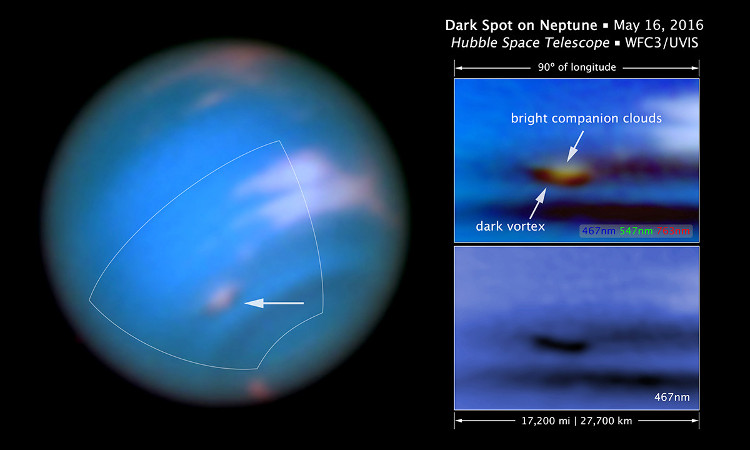Giant hurricane on the star of the Neptune's sights on Hubble's sight
A giant storm suddenly appeared on Neptune causing a stir. Their kinetic simulations suggest that this storm may drift to the equator.
NASA has the opportunity to examine the surface of Neptune, when a giant oval storm is discovered .

The dark color material in the storm could be hydrogen sulfide, with the pungent odor of rotten eggs.(Image source: phys).
Like Jupiter's typhoon, Neptune's latest typhoon has a coiled, oval structure, containing many magnetic materials inside with the most extreme winds on the starfish.
The dark color material in the storm could be hydrogen sulfide , with the pungent odor of rotten eggs. Joshua Tollefson from the University of California at Berkeley explains, "These energy particles are still highly reflective, they are only slightly darker than the particles in the surrounding air."
Unlike Jupiter's GRS, which was seen for at least 200 years, Neptune's dark vortex lasted only a few years. This is the first photo taken when it is in the process of dying.
Mr. Agustín Sánchez-Lavega, of the Basque Country University in Spain, said: "We have no evidence to show how fast these vortices are formed or the speed of rotation. It is likely that they arise from instability in the east and west winds in Neptune's atmosphere ".
"Their kinetic simulations suggest that this storm will probably drift to the equator. We think that when the vortex is too close to the equator, it will disintegrate and can create a spectacular explosion in the cloud".
- Witness the giant star's death
- Beautiful sight of a dying star
- For the first time, a star has been discovered in a star
- The giant red star revives 'zombie star' that confuses the researcher
- The terrible secret of giant red stars
- How the strange star reveals the Sun will
- Mysterious giant star on the surface of the Earth
- The mystery of the star escapes the largest black hole in the Milky Way
- Video: Fly through a dead star's body
- Giant stars are created from 'star nursery'.
- The star is about to explode 1,400 times larger than the Sun.
- Deadly giant stars swallow their companions
 Van Allen's belt and evidence that the Apollo 11 mission to the Moon was myth
Van Allen's belt and evidence that the Apollo 11 mission to the Moon was myth The levels of civilization in the universe (Kardashev scale)
The levels of civilization in the universe (Kardashev scale) Today Mars, the sun and the Earth are aligned
Today Mars, the sun and the Earth are aligned The Amazon owner announced a secret plan to build a space base for thousands of people
The Amazon owner announced a secret plan to build a space base for thousands of people 2024 Atlantic Hurricane Season Ends, Leaving Widespread Damage in Its wake
2024 Atlantic Hurricane Season Ends, Leaving Widespread Damage in Its wake  Storm No. 9 Manyi, level 12, about 200km from Hoang Sa archipelago
Storm No. 9 Manyi, level 12, about 200km from Hoang Sa archipelago  Video: Close-up of the terrible path of the Habood dust storm, causing 15 thousand people in the US to lose power
Video: Close-up of the terrible path of the Habood dust storm, causing 15 thousand people in the US to lose power  Typhoon Tra Mi forms in the East of the Philippines, likely to strengthen into a hurricane when entering the East Sea
Typhoon Tra Mi forms in the East of the Philippines, likely to strengthen into a hurricane when entering the East Sea  Storm Trami will reach its maximum intensity when it approaches the Paracel Islands.
Storm Trami will reach its maximum intensity when it approaches the Paracel Islands.  Storm Tra Mi enters the East Sea today, strange movement direction
Storm Tra Mi enters the East Sea today, strange movement direction 